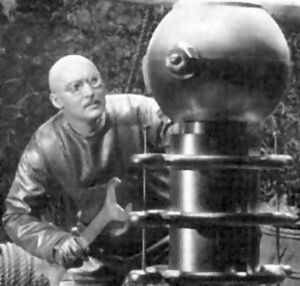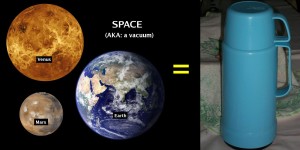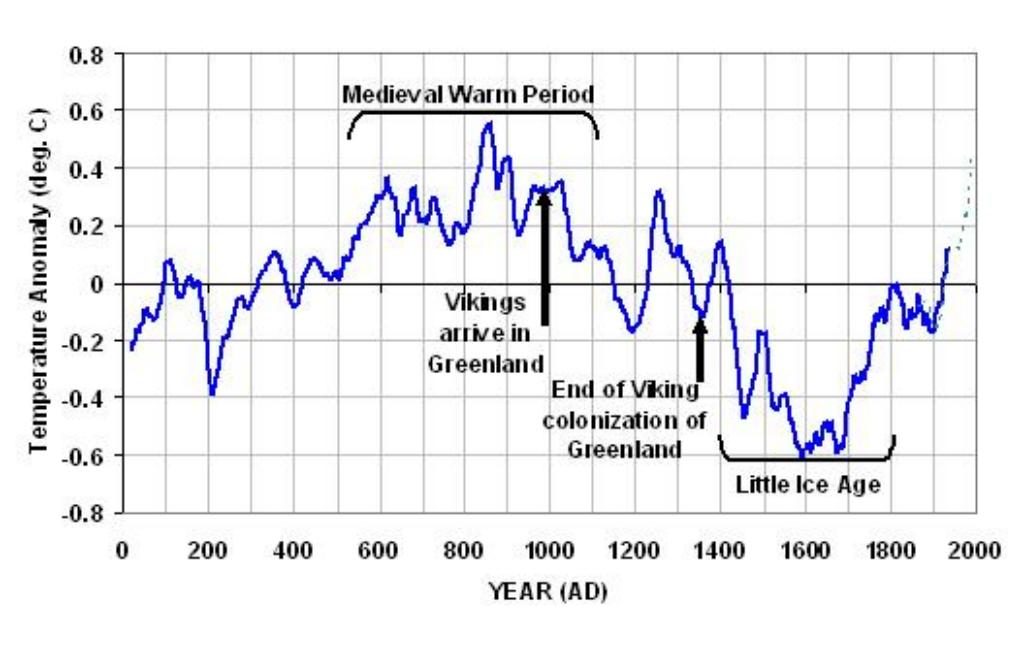 Click for a larger image. (It’s worth it.)
Click for a larger image. (It’s worth it.)
 Global Warming
Global Warming
Let’s see: here’s a snapshot of current news as I write this (July 2017).
It’s very hot in the Southwestern United States. Some are blaming this on Global Warming.
An article in the journal Nature acknowledged that the Earth is not warming as quickly as predicted. The abstract contains the admission, “… satellite-derived tropospheric warming trends were generally smaller than trends estimated from a large multi-model ensemble.”
Dr. Stephen Hawking recently observed that Earth could become like Venus because of Trump’s withdrawal from the Paris Accords. A Twitter-storm followed, mostly negative, even from some Global Warming activists.
I’m personally glad that The Hawk-Man made that statement, because it’s a perfect lead-in to what I’ve been working on for the past several months.
![]()
As usual, I will oversimplify this. (Also as usual, you can thank me later.) I’m not going to use geeky terms and weird math. There’s plenty of that online, starting with, say, Wikipedia’s article on greenhouse gases. Knock yourself out.
But whether you’re “fer” it or “agin” it, I want you to understand what you’re actually arguing about.
See my discussion, “How Science Works,” for a brief refresher on the scientific method, what scientific theories are, and how they’re crafted, tested and applied.
In particular, never forget this: scientific theories cannot be proven, they can only be disproven. You craft a theory/model/predictive thing, then test the daylights out of it. All it takes is one verifiable case where the predictions don’t match the results for a theory to be falsified. The model needs to be repaired.
Venus: The Tropical World!
We discussed Earth’s “sister” planet Venus on the page, A Home For Life. But here’s a quick historical perspective behind Hawking’s comment. Perhaps it will amuse you as much as it did me while I was writing it.
Mercury is the closest planet to our Sun, with an orbit roughly 1/3 of Earth’s distance. You’d expect it to be hot; it is. The orbit of Venus is a bit over 2/3 of our distance, not quite within the habitable zone. But years ago, some scientists wondered if the thick cloud cover could keep Venus cool enough for life.
Venus has the highest albedo of the 8 planets, so most sunlight is reflected away from it. That, and the fact that it’s our closest neighbor, is why you can see Venus when it’s in the daytime sky.
It wasn’t a stretch in the 1940’s and 50’s to imagine a steaming hot, swampy tropical planet filled with exotic lifeforms. (See the comic at the top of this page.) Some great classic science fiction was written about the exploration and colonization of Venus …
… .. .. and they couldn’t have been more wrong.

The actual surface of Venus
(from the Venera 13 probe).
“IT B HOT LOLZ”
The Mariner 2 probe made a flyby of Venus in 1962 and sent back to Earth: “hey, dis thing B HOT LOLZ!”
The Soviets had their own Venera program to study Venus more closely. Venera 4 made it to Venus in 1967, but never landed. Its parachute kept it aloft until the batteries ran out, thanks to the ridiculously dense atmosphere. Before it died, it echoed what Mariner had said: Это горячо! This thing is hot!
Veneras 5 and 6 were more heavily built and had smaller ‘chutes, but still couldn’t make it to the surface … so the Soviets closed their eyes and hummed for a bit. Then they called forth their Inner Wild Russian and built Venera 7 — basically, an interplanetary tank.
Venera 7 landed and lived just long enough (about 23 minutes) to confirm a surface temperature of 860-870 degrees Fahrenheit. The atmospheric pressure was 90 times that of Earth’s and there was virtually no water. The terrain was scorched and barren.
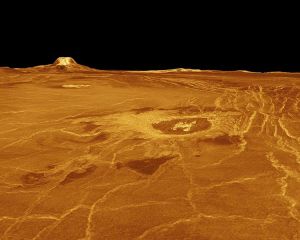
A view from the Magellan probe.
Sagan’s Greenhouse Effect
When scientists see something that they can’t explain, they start crunching numbers and looking for answers. The earlier math about Venus’ cloud cover reflecting most sunlight obviously didn’t match the observations. So why was Venus the hottest planet in our solar system?
Enter: a young astronomer named Carl Sagan. Even before the first probe was launched, he had argued that Venus was probably hot, caused by what he called a “runaway greenhouse effect.” (Ah.)
Once they had hard data from Venus, scientists took another look at Sagan’s math. They concluded that the thick atmosphere — primarily carbon dioxide (ah again!), with upper layers of sulfuric acid and sulfur dioxide — would efficiently trap heat.
The math worked, it made sense and they patted themselves on the back.
Now let’s see what this means for us here on Earth, and why this worries a lot of people.

Venera 13. Built like a battleship.
This one lasted for a whopping
2 hours and 7 minutes on Venus.
Space ≅ Thermostm Bottle
The average laycreature wonders, “what’s the big deal?” Things heat up, then cool down. Right? We open windows or crank an air conditioner. If we’re in a hurry, we might douse that Hot Thing(tm) with cold water or pack it in ice.
But in all of those cases, you’re depending on physical contact to transfer heat, whether with cooler air or with ice or whatever. Also, note that I said transfer: your AC doesn’t actually cool your home, it moves the heat from inside the building to the great outdoors.
The point of the above (rather artistic, if I say so myself) picture is this: the only way that heat can be moved through a vacuum is by radiation. It’s not a very good way to cool things off.
That’s why your chickie doodle soup will stay hot for hours in a classic Thermos® bottle. Very little heat can pass through the vacuum and the mirrored glass (which reflects radiation).
Now, granted, the Earth doesn’t have a mirrored sky (unless you’ve been taking some really odd drugs, but let’s press on). We do radiate some excess heat back into space. But the concern is that, if we add or trap more heat than we can shed, Mamma Earth might get too warm. (Again: ah.)
Greenhouse Science
The Sun’s radiation strikes Earth, warming it up. Some is reflected or radiated back into space. Certain gasses, most notably water vapor and carbon dioxide, “trap” the heat. See the picture below.
The science behind Anthropogenic (i.e., “man-caused”) global warming, or “AGW,” is that we’re emitting too much greenhouse gas, especially carbon dioxide. You get CO2 anytime you burn something with carbon, whether it’s gasoline in a car or coal in a power plant.
Ergo, the Climate Change folks argue, we are warming up, slowly but surely. As we warm, the ice caps at the poles will melt, the oceans will rise, we’ll have more water vapor and we’ll warm even more.
Eventually, we could have a runaway greenhouse effect. Earth could become a second Venus.
There’s the argument in a nutshell. Now for the promised graphic:
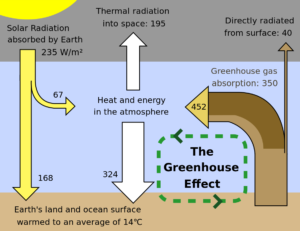
The Greenhouse Effect, illustrated.
Interlude …
Now! If I was to stop there, I’d leave the Climate Change/Global Warming/Whatever folks happy.
But you know me … I cain’t hep myself. Let’s dig a bit deeper. Before I start, though, please read the following carefully.
- There is some evidence that our planet has grown a bit warmer over the past century. How much? This is hotly disputed. Regardless of what you’ve read elsewhere, the cause is disputed as well.
- We do need to move away from fossil fuels. I am not willing to wreck the economy to do it, but I agree that we need to gradually switch to alternative energy sources that make sense and which are cost effective. (Read that carefully.)
I had to state that clearly for a reason. Most people — me included — are sick and tired of so-called “experts,” politicians and bureaucrats deciding something and then calling us names if we don’t accept their solutions en toto.

Pictured: a typical politician.
Politicization
Scientists, as a general rule, try to be apolitical. That has become very difficult in the past few decades, because the largest source of funding is government, and government money almost always comes with strings attached.
Simply put, you learn early in your scientific career that if, say, the current president or prime minister thinks that certain additives cause birth defects, then your study had better not conclude that they’re safe. You’ll get no more funding.
If you’re convinced you’re right and that the Official Government Position(tm) is wrong, you’ll have to get your money from private sources. These are typically large industry groups with their own agenda and a strong desire to maintain the status quo.
Global warming activists will instantly point that out. They’ll quickly dismiss all of your work as tainted and untrustworthy. (The fact that their money-folks have agendas of their own — some of them even believe that Earth is a living, breathing thingie called “Gaia,” which is odd enough to be going along with — should be ignored.)

Wikimedia Commons returned this image
when I did a search on “follow the money.”
(No, I have no idea what it means, either.)
Computer Models
Computer models are wonderful. I use them in my own job. You feed in some numbers, run the model software, and the output should tell you something useful. But computer models have two serious limitations:
- None of them are perfect.
- Even if they were perfect, the quality of the output is directly dependent on the quality of the input (it’s that “GIGO” thing: garbage in, garbage out).
This is especially true of the big, gigantic and large multi-model ensembles that are all the rage now. You can get results that range from pretty good to dismal. Economic models typically fall into the latter category (but don’t tell that to Big Thinker economists like Paul Krugman; it’ll hurt their feelings).
During the Great Recession, the pundits would say things like, “the 2nd quarter jobs numbers were disappointing. They were below projections.” They believe in these big, sprawling mega-models, folks, even though they’ve been wrong more often than right. They were honestly surprised and disappointed.

… and Wikimedia returned this after a search
for “economics art.” That place is wonderful.
Weather Models
The models used for weather forecasting are better than the economic jobs. They’ve been tinkered with and improved for decades against a mountain of good, hard data … and they still get it wrong sometimes.
Back in 2014, the National Weather Service (NWS) here in Alabama predicted that we might get a little snow, but “no significant accumulation” was expected in the Birmingham area. Everyone went to work or school as usual.
I was at a transmitter site when the snow started. When I saw how hard it was coming down, I locked up and sent my wife a text: let’s go. On my way to pick her up, our talk radio station was still saying, “the snow should end anytime now.” I called up and said, “guys, it ain’t stopping. The weather forecast is wrong.”
Using an ensemble of excellent, well-tested models, the NWS did the best job that they could. But we had thousands of people stranded in cars, kids stuck at school, folks unable to leave work. The models had blown it.

We just ain’t wired for this in Alabama.
![]()
To be fair to the NWS, they’ve warned us many times that their models aren’t as good at predicting snow in the Southeastern US. A number of things must happen in just the right way for us to get white stuff.
But the takeaway is this: if you stretch a model into an area where there’s a lot of uncertainty, or incomplete (or incorrect) data, it’s going to blow the prediction. (Ah.)
By the way: if you try to use weather forecasting as an example to a true AGW activist, oh, how he or she will howl! “It’s not the same thing, dunderhead! Moron! Doofuss!”
Sure. There are key differences between predicting global average temperatures and specific storm activity. But I can still make a valid point: if, after decades of refinement, we still can’t predict the weather with 100% accuracy, how in the world can you predict what average temperatures will be in 2050 or 2100?
You can’t. And — drum roll, please! — if the model is built on flawed assumptions, it won’t be accurate in any case.

OK, Wikimedia. This is getting silly.
Earth != Venus
Time to start wrapping this up. It’s too long already. But at the risk of stating the obvious, let me state the obvious: Earth ain’t Venus. To start with, our planet doesn’t have an atmospheric pressure of over 1,300 lbs per square inch. We also have a strong magnetic field, a large moon that creates tides in our huge oceans, a CO2 level of only .04% … and so on. (Again: see the discussion in “A Home For Life.”)
More importantly, Earth has biofeedback mechanisms that regulate the temperature. Our planet has lots of life that uses carbon dioxide.
Speaking from experience, AGW activists are always surprised to learn that there are plenty of good, solid scientific minds that disagree with the Global Warming alarmists. (The oft-quoted “97% figure” is based on an amusing metric: “only those who agree with us are allowed to disagree.” But let’s press on.)
Dr. Roy Spencer of the University of Alabama in Huntsville is one well-known skeptic. His Website is highly recommended. He thinks that, even if Earth does get warmer, cloud patterns will change and will expose more of our planet’s surface to space, allowing more heat to be radiated.
One neat thing that I found at his Website is an article containing the image shown below. Earth has been “warm” before — like, during the middle ages. That’s when — and why — the Vikings colonized Greenland.
In Sum
Earth has not warmed as much as the alarmists have claimed that it would. That’s the bottom line. The article in Nature, referenced above, finally admits that.
Even if the Earth is warming, it’s more likely that the cause is not humans, but external influences (like solar output). Before I will allow the activists to wreck the economy, they need to do more work. Just saying, “Neil Degrasse Tyson believes it!” ain’t gonna get it. Sure, I respect Dr. Tyson, but … well, sorry. No.
Global Warming activists want this to be cut and dried; they claim that it’s settled science and that we’d better get cracking. Some are saying that it’s already too late.
Meanwhile, a guy with the Russian Academy of Sciences (and a totally unpronounceable name) has done a study that finds that, not only is the Earth not warming, long-term, we’re headed for another ice age. In fact, he says it has already begun! So much for “settled” science.
Before I say, “Nuff Zedd” on this one, two more links. My brother has also been looking at this for some years. His latest is called, “the Global Warming Hoax.” (Heh.) He makes a great point about CO2 and its ability to End The Word. Well worth the time. The second is the classic Watts Up With That. That’s the best all-around site for a balanced look at climate news.
Now: Nuff Zedd!


